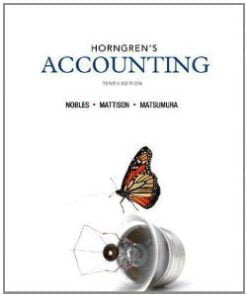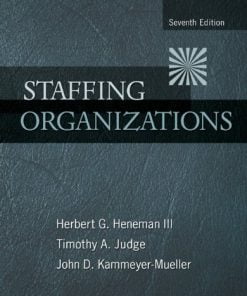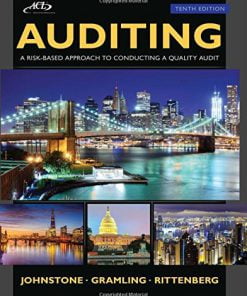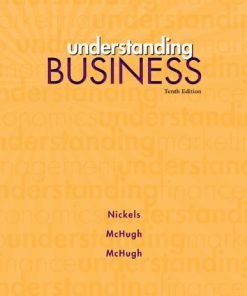Solutions manual for Fundamentals of Corporate Finance 3e by Berk 9780133576870
$35.00 Original price was: $35.00.$26.50Current price is: $26.50.
Solutions manual for Fundamentals of Corporate Finance 3e by Berk 9780133576870
This is completed downloadable of Solutions manual for Fundamentals of Corporate Finance 3e by Berk 9780133576870
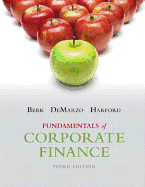
Product Details:
- ISBN-10 : 1269945645
- ISBN-13 : 978-0133507911
- Author: Jonathan Berk (Author), Peter DeMarzo (Author), Jarrad Harford (Author)
Fundamentals of Corporate Finance ’s applied perspective cements your understanding of modern-day core principles, focusing on problem solving and real-life financial management practices—all within a clear valuation framework.
Table of Content:
- Part 1 Introduction
- Chapter 1 Corporate Finance and the Financial Manager
- Learning Objectives
- 1.1 Why study finance?
- 1.2 The three types of firms
- Sole traders
- Partnerships
- Corporations
- Tax implications for corporate entities
- 1.3 The financial manager
- Making investment decisions
- Making financing decisions
- Managing short-term cash needs
- The goal of the financial manager
- 1.4 The financial manager’s place in the corporation
- The corporate management team
- Ethics and incentives in corporations
- 1.5 The stock market
- The largest stock markets
- Traditional trading venues
- Dark pools
- 1.6 Financial institutions
- The financial cycle
- Types of financial institutions
- Roles of financial institutions
- Mylab Finance
- Problems
- The three types of firms
- The financial manager
- The financial manager’s place in the corporation
- The stock market
- Financial institutions
- Notes
- Chapter 2 Introduction to financial statement analysis
- Learning Objectives
- 2.1 Firms’ disclosure of financial information
- International financial reporting standards
- Preparation of financial statements
- Types of financial statements
- 2.2 The balance sheet
- Assets
- Liabilities
- Shareholders’ equity
- 2.3 Balance sheet analysis
- Market-to-book ratio
- Debt–equity ratio
- Enterprise value
- Other balance sheet information
- 2.4 The income statement
- Earnings calculations
- 2.5 Income statement analysis
- Profitability ratios
- Asset efficiency
- Working capital ratios
- EBITDA
- Leverage ratios
- Investment returns
- The DuPont Identity
- Valuation ratios
- 2.6 The statement of cash flows
- Operating activity
- Investment activity
- Financing activity
- 2.7 Other financial statement information
- Management discussion and analysis
- Statement of changes in equity
- Notes to the financial statements
- 2.8 Financial reporting in practice
- Enron
- HIH insurance
- Centro
- CLERP 9 and the ASX Good Corporate Governance Principles
- The financial statements: A useful starting point
- Mylab finance
- Review Questions
- Problems
- Firms’ disclosure of financial information
- The balance sheet
- Balance sheet analysis
- The income statement and income statement analysis
- The statement of cash flows
- Accounting manipulation
- Data Case
- Notes
- Part 2 Interest rates and valuing cash flows
- Chapter 3 Time value of money: an introduction
- Learning Objectives
- 3.1 Cost–benefit analysis
- Role of the financial manager
- Quantifying costs and benefits
- 3.2 Market prices and the valuation principle
- The Valuation Principle
- Why there can be only one competitive price for a good
- 3.3 The time value of money and interest rates
- The time value of money
- The interest rate: Converting cash across time
- Timelines
- 3.4 Valuing cash flows at different points in time
- Rule 1: Comparing and combining values
- Rule 2: Compounding
- Rule 3: Discounting
- Mylab Finance
- Review Questions
- Problems
- Cost–benefit analysis
- Market prices and the Valuation Principle
- The time value of money and interest rates
- Valuing cash flows at different points in time
- Notes
- Chapter 4 Time value of money: valuing cash flow streams
- Learning Objectives
- 4.1 Valuing a stream of cash flows
- Applying the rules of valuing cash flows to a cash flow stream
- 4.2 Perpetuities
- 4.3 Annuities
- Present value of an annuity
- Future value of an annuity
- 4.4 Growing cash flows
- Growing perpetuity
- Growing annuity
- 4.5 Solving for variables other than present value or future value
- Solving for the cash flows
- Rate of return
- Solving for the number of periods
- 4.6 Non-annual cash flows
- Summing it up
- Mylab Finance
- Review Questions
- Problems
- Valuing a stream of cash flows
- Perpetuities
- Annuities
- Growing cash flows
- Solving for variables other than present value or future value
- Valuing cash flow streams with non-annual cash flows
- Data case
- Notes
- Chapter 5 Interest Rates
- Learning Objectives
- 5.1 Interest rate quotes and adjustments
- The effective annual rate
- Adjusting the discount rate to different time periods
- Annual percentage rates
- 5.2 Application: discount rates and loans
- Calculating loan payments
- Calculating the outstanding loan balance
- 5.3 The determinants of interest rates
- Inflation and real versus nominal rates
- Investment and interest rate policy
- The yield curve and discount rates
- The yield curve and the economy
- 5.4 The opportunity cost of capital
- Mylab Finance
- Review Questions
- Problems
- Interest rate quotes and adjustments
- Application: Discount rates and loans
- The determinants of interest rates
- The opportunity cost of capital
- Notes
- Chapter 6 Bond valuation
- Learning Objectives
- 6.1 Bond terminology
- 6.2 Zero-coupon bonds
- Zero-coupon bond cash flows
- Yield to maturity of a zero-coupon bond
- Risk-free interest rates
- 6.3 Coupon bonds
- Coupon bond cash flows
- Yield to maturity of a coupon bond
- Coupon bond price quotes
- 6.4 Why bond prices change
- Interest rate changes and bond prices
- Time and bond prices
- Interest rate risk and bond prices
- Bond prices in practice
- 6.5 Corporate bonds
- Credit risk
- Corporate bond yields
- Bond ratings
- Credit spreads
- Mylab Finance
- Review Questions
- Problems
- Bond terminology
- Zero-coupon bonds
- Coupon bonds
- Why bond prices change
- Corporate bonds
- Data Case
- Notes
- Chapter 7 Share valuation: the dividend-discount model
- Learning Objectives
- 7.1 Share basics
- Stock market reporting: Share quotes
- Ordinary shares
- Preference shares
- 7.2 The dividend-discount model
- A one-year investor
- Dividend yields, capital gains and total returns
- A multiyear investor
- Dividend-discount model equation
- 7.3 Estimating dividends in the dividend-discount model
- Constant dividend growth
- Dividends versus investment and growth
- Changing growth rates
- Value drivers and the dividend-discount model
- 7.4 Limitations of the dividend-discount model
- Uncertain dividend forecasts
- Non-dividend-paying shares
- 7.5 Share repurchases and the total payout model
- 7.6 Putting it all together
- Mylab Finance
- Review Questions
- Problems
- Share basics
- The dividend-discount model
- Estimating dividends in the dividend-discount model
- Share repurchases and the total payout model
- Notes
- Part 3 Valuation and the firm
- Chapter 8 Investment decision rules
- Learning Objectives
- 8.1 The NPV decision rule
- Net present value
- The NPV decision rule
- 8.2 Using the NPV rule
- Organising the cash flows and computing the net present value
- The NPV profile
- Measuring sensitivity with the internal rate of return
- Alternative rules versus the NPV rule
- 8.3 Alternative decision rules
- The payback rule
- The IRR rule
- Modified internal rate of return
- 8.4 Choosing between projects
- Differences in scale
- Timing of the cash flows
- 8.5 Evaluating projects with different lives
- Important considerations when using the equivalent annual annuity
- 8.6 Choosing among projects when resources are limited
- Evaluating projects with different resource requirements
- 8.7 Putting it all together
- Mylab Finance
- Review Questions
- Problems
- The NPV decision rule
- Using the NPV rule
- Alternative decision rules
- Evaluating projects with different lives
- Choosing among projects when resources are limited
- Data case
- Notes
- Chapter 9 Fundamentals of capital budgeting
- Learning Objectives
- 9.1 The capital budgeting process
- 9.2 Forecasting incremental earnings
- Operating expenses versus capital expenditures
- Incremental revenue and cost estimates
- Taxes
- Incremental earnings forecast
- 9.3 Determining incremental free cash flow
- Converting from earnings to free cash flow
- Calculating free cash flow directly
- Calculating the net present value
- 9.4 Other effects on incremental free cash flow
- Opportunity costs
- Project externalities
- Sunk costs
- Adjusting free cash flow
- Replacement decisions
- 9.5 Analysing the project
- Sensitivity analysis
- Break-even analysis
- Scenario analysis
- 9.6 Real options in capital budgeting
- Option to delay
- Option to expand
- Option to abandon
- Mylab Finance
- Review Questions
- Problems
- Forecasting incremental earnings
- Determining incremental free cash flow
- Other effects on incremental free cash flows
- Analysing the project
- Real options in capital budgeting
- Data Case
- Notes
- Chapter 10 Share valuation: a second look
- Learning Objectives
- 10.1 The discounted free cash flow model
- Valuing the enterprise
- Implementing the model
- Connection to capital budgeting
- 10.2 Valuation based on comparable firms
- Valuation multiples
- Limitations of multiples
- Comparison with discounted cash flow methods
- Share valuation techniques: The final word
- 10.3 Information, competition and share prices
- Information in share prices
- Competition and efficient markets
- Lessons for investors and corporate managers
- The efficient markets hypothesis versus no arbitrage
- 10.4 Individual biases and trading
- Excessive trading and overconfidence
- Hanging on to losers and the disposition effect
- Investor attention, mood and experience
- Mylab Finance
- Review Questions
- Problems
- The discounted free cash flow model
- Valuation based on comparable firms
- Information, competition and share prices
- Individual biases and trading
- Data Case
- Notes
- Part 4 Risk and return
- Chapter 11 Risk and return in capital markets
- Learning Objectives
- 11.1 A first look at risk and return
- 11.2 Historical risks and returns of shares
- Computing historical returns
- Average annual returns
- The variance and volatility of returns
- The normal distribution
- 11.3 The historical trade-off between risk and return
- The returns of large portfolios
- The returns of individual shares
- 11.4 Common versus independent risk
- Theft versus earthquake insurance: An example
- Types of risk
- 11.5 Diversification in share portfolios
- Unsystematic versus systematic risk
- Diversifiable risk and the risk premium
- The importance of systematic risk
- Mylab Finance
- Review Questions
- Problems
- Historical risks and returns of shares
- Common versus independent risk
- Diversification in share portfolios
- Notes
- Chapter 12 Systematic risk and the equity risk premium
- Learning Objectives
- 12.1 The expected return of a portfolio
- Portfolio weights
- Expected portfolio return
- 12.2 The volatility of a portfolio
- Diversifying risks
- Measuring shares’ co-movement: Correlation
- Computing a portfolio’s variance and standard deviation
- The volatility of a large portfolio
- 12.3 Measuring systematic risk
- Role of the market portfolio
- Stock market indices as the market portfolio
- Market risk and beta
- Estimating beta from historical returns
- 12.4 Putting it all together: the capital asset pricing model
- The CAPM equation relating risk to expected return
- The security market line
- The Capital Asset Pricing Model and portfolios
- Summary of the Capital Asset Pricing Model
- The big picture
- Mylab Finance
- Review Questions
- Problems
- The expected return of a portfolio
- The volatility of a portfolio
- Measuring systematic risk
- Putting it all together: The Capital Asset Pricing Model
- Notes
- Chapter 13 The cost of capital
- Learning Objectives
- 13.1 A first look at the weighted average cost of capital
- The firm’s capital structure
- Opportunity cost and the overall cost of capital
- Weighted averages and the overall cost of capital
- Weighted average cost of capital calculations
- 13.2 The firm’s costs of debt and equity capital
- Cost of debt capital
- Cost of preference share capital
- Cost of ordinary share capital
- 13.3 A second look at the weighted average cost of capital
- Weighted average cost of capital equation
- Weighted average cost of capital in practice
- Methods in practice
- 13.4 Using the weighted average cost of capital to value a project
- Key assumptions
- WACC method application: Extending the life of a mine
- Summary of the WACC method
- 13.5 Project-based costs of capital
- Cost of capital for a new acquisition
- Divisional costs of capital
- 13.6 When raising external capital is costly
- Mylab Finance
- Review Questions
- Problems
- A first look at the weighted average cost of capital
- The firm’s costs of debt and equity capital
- A second look at the weighted average cost of capital
- Using the weighted average cost of capital to value a project
- Project-based costs of capital
- When raising external capital is costly
- Data Case
- Notes
- Part 5 Long-term financing
- Chapter 14 Raising capital
- Learning Objectives
- 14.1 Equity financing for private companies
- Sources of funding
- Securities and valuation
- Exiting an investment in a private company
- 14.2 Taking your firm public: The initial public offering
- Advantages and disadvantages of going public
- Primary and secondary IPO offerings
- Other IPO types
- 14.3 IPO puzzles
- Underpriced IPOs
- ‘Hot’ and ‘cold’ IPO markets
- High cost of issuing an IPO
- Poor post-IPO long-run share performance
- 14.4 Raising additional capital: The seasoned equity offering
- SEO process
- SEO price reaction
- SEO costs
- MyLab Finance
- Review questions
- Problems
- Equity financing for private companies
- Taking your firm public: The initial public offering
- Raising additional capital: The seasoned equity offering
- Notes
- Chapter 15 Debt Financing
- Learning Objectives
- 15.1 Corporate debt
- Private debt
- Public debt
- 15.2 Bond covenants
- Types of covenants
- Advantages of covenants
- 15.3 Repayment provisions
- Call provisions
- Sinking funds
- Convertible provisions
- MyLab Finance
- Review questions
- Problems
- Corporate debt
- Repayment provisions
- Notes
- Part 6 Capital structure and valuation
- Chapter 16 Capital structure
- Learning Objectives
- 16.1 Capital structure choices
- Capital structure choices across industries
- Capital structure choices within industries
- 16.2 Capital structure in perfect capital markets
- Application: Financing a new business
- Leverage and firm value
- The effect of leverage on risk and return
- Home-made leverage
- Leverage and the cost of capital
- Modigliani and Miller and the real world
- 16.3 Debt and taxes
- The interest tax deduction and firm value
- Value of the interest tax shield
- The interest tax shield with permanent debt
- Leverage and the weighted average cost of capital with taxes
- Debt and taxes: The bottom line
- 16.4 The costs of bankruptcy and financial distress
- Direct costs of bankruptcy
- Indirect costs of financial distress
- 16.5 Optimal capital structure: The trade-off theory
- Differences across firms
- Optimal leverage
- 16.6 Additional consequences of leverage: Agency costs and information
- Agency costs
- Debt and information
- 16.7 Capital structure: Putting it all together
- MyLab Finance
- Review Questions
- Problems
- Capital structure in perfect capital markets
- Debt and taxes
- Optimal capital structure: The trade-off theory
- Additional consequences of leverage: Agency costs and information
- Notes
- Chapter 17 Payout policy
- Learning Objectives
- 17.1 Cash distributions to shareholders
- Dividends
- Share repurchases
- 17.2 Dividends versus share repurchases in a perfect capital market
- Alternative policy 1: Pay a dividend with excess cash
- Alternative policy 2: Share repurchase (no dividend)
- Alternative policy 3: High dividend (equity issue)
- Modigliani–Miller and dividend policy irrelevance
- Dividend policy with perfect capital markets
- 17.3 Dividends and share repurchases under personal taxes
- Taxes on dividends and capital gains
- Dividend imputation
- Taxation of capital gains
- Dividends versus capital gains
- Share repurchases structured as dividends
- Optimal dividend policy with taxes
- 17.4 Payout versus retention of cash
- Retaining cash with perfect capital markets
- Retaining cash with imperfect capital markets
- 17.5 Signalling with payout policy
- Dividend smoothing
- Dividend signalling
- Signalling and share repurchases
- 17.6 Dividend reinvestment plans and bonus issues
- Dividend reinvestment plans
- Bonus issues
- 17.7 Dividend imputation and share valuation
- Valuation and franking credits: The theory
- Estimating gamma
- Valuation and franking credits: Market practice
- 17.8 Advice for the financial manager
- MyLab Finance
- Review questions
- Problems
- Cash distributions to shareholders
- Dividends versus share repurchases in a perfect capital market
- The tax disadvantage of dividends
- Payout versus retention of cash
- Signalling with payout policy
- Dividend reinvestment plans and bonus issues
- Dividend imputation and share valuation
- Data case
- Notes
- Part 7 Financial planning
- Chapter 18 Financial modelling and pro-forma analysis
- Learning Objectives
- 18.1 Goals of long-term financial planning
- Identify important linkages
- Analyse the impact of potential business plans
- Plan for future funding needs
- 18.2 Forecasting financial statements: The per cent of sales method
- Per cent of sales method
- Pro-forma income statement
- Pro-forma balance sheet
- Making the balance sheet balance: Net new financing
- Choosing a forecast target
- 18.3 Forecasting a planned expansion
- KMS Designs’ expansion: Financing needs
- KMS Designs’ expansion: Pro-forma statement
- Forecasting the balance sheet
- 18.4 Growth and firm value
- Sustainable growth rate and external financing
- 18.5 Valuing the expansion
- Forecasting free cash flows
- KMS Designs’ expansion: Effect on firm value
- MyLab Finance
- Review questions
- Problems
- Forecasting a planned expansion
- Growth and firm value
- Valuing the expansion
- Notes
- Chapter 19 Working capital management
- Learning Objectives
- 19.1 Overview of working capital
- The cash cycle
- Working capital needs by industry
- Firm value and working capital
- 19.2 Trade credit
- Trade credit terms
- Trade credit and market frictions
- Managing float
- 19.3 Receivables management
- Determining the credit policy
- Monitoring accounts receivable
- 19.4 Payables management
- Determining accounts payable days outstanding
- Stretching accounts payable
- 19.5 Inventory management
- Benefits of holding inventory
- Costs of holding inventory
- 19.6 Cash management
- Motivation for holding cash
- Alternative investments
- MyLab Finance
- Review questions
- Problems
- Overview of working capital
- Trade credit
- Receivables management
- Payables management
- Inventory management
- Data case4
- Notes
- Part 8 Special topics
- Chapter 20 Option applications and corporate finance
- Learning Objectives
- 20.1 Option basics
- Option contracts
- Share option quotations
- Options on other financial securities
- 20.2 Option payoffs at expiration
- The long position in an option contract
- The short position in an option contract
- Profits for holding an option to expiration
- Returns for holding an option to expiration
- 20.3 Factors affecting option prices
- Exercise price and share price
- Option prices and the exercise date
- Option prices and the risk-free rate
- Option prices and volatility
- 20.4 The Black Scholes option pricing formula
- 20.5 Put call parity
- Portfolio insurance
- 20.6 Options and corporate finance
- MyLab Finance
- Review questions
- Problems
- Option payoffs at expiration
- Factors affecting option prices
- Put call parity
- Options and corporate finance
- Data Case
- Notes
- Chapter 21 Mergers and acquisitions
- Learning Objectives
- 21.1 Background and historical trends
- Merger waves
- Types of mergers
- 21.2 Market reaction to a takeover
- 21.3 Reasons to acquire
- Economies of scale and scope
- Vertical integration
- Expertise
- Monopoly gains
- Efficiency gains
- Tax savings from operating losses
- Diversification
- Earnings growth
- Managerial motives to merge
- 21.4 The takeover process
- Valuation
- The offer
- Merger ‘arbitrage’
- Tax and accounting issues
- Board and shareholder approval
- 21.5 Takeover defences
- Poison pills
- Staggered boards
- White knights
- Golden parachutes
- Recapitalisation
- Other defensive strategies
- 21.6 Who gets the value added from a takeover?
- The free rider problem
- Toeholds
- Leveraged buyouts
- Competition
- MyLab Finance
- Review questions
- Problems
- The takeover process
- Takeover defences
- Who gets the value added from a takeover?
- Notes
- Chapter 22 International corporate finance
- Learning Objectives
- 22.1 Foreign exchange
- The foreign exchange market
- Exchange rates
- 22.2 Exchange rate risk
- Exchange rate fluctuations
- Hedging with forward contracts
- Cash-and-carry and the pricing of currency forwards
- Hedging exchange rate risk with options
- 22.3 Internationally integrated capital markets
- 22.4 Valuation of foreign currency cash flows
- Application: Ityesi Packaging
- The Law of One Price as a robustness check
- 22.5 Valuation and international taxation
- A single foreign project with immediate repatriation of earnings
- Multiple foreign projects and deferral of earnings repatriation
- 22.6 Internationally segmented capital markets
- Differential access to markets
- Macro-level distortions
- Implications of internationally segmented capital markets
- 22.7 Capital budgeting with exchange rate risk
- Application: Ityesi Packaging
- Conclusion
- MyLab Finance
- Review questions
- Problems
- Foreign exchange
- Exchange rate risk
- Internationally integrated capital markets
- Valuation of foreign currency cash flows
- Valuation and international taxation
- Internationally segmented capital markets
- Capital budgeting with exchange rate risk
- Data Case
- Notes
- Chapter 23 Insurance and risk management
- Learning Objectives
- 23.1 Insurance
- The role of insurance: An example
- Insurance pricing in a perfect market
- The value of insurance
- The costs of insurance
- The insurance decision
- 23.2 Commodity price risk
- Hedging with vertical integration and storage
- Hedging with long-term contracts
- Hedging with futures contracts
- 23.3 Interest rate risk
- Interest rate risk measurement: Duration
- Duration-based hedging
- Swap-based hedging
- MyLab Finance
- Review questions
- Problems
- Insurance
- Commodity price risk
- Interest rate risk
- Notes
People Also Search:
fundamentals of corporate finance
fundamentals of corporate finance 3e by berk
fundamentals of corporate finance 3e by berk download scribd
fundamentals of corporate finance 3e by berk solution manual download pdf
Related products
Solution Manual
Solution Manual
International Accounting Doupnik 4th Edition Solutions Manual
Solution Manual
Solution Manual
Auditing A Risk Based-Approach to Conducting a Quality Audit Johnstone 10th Edition Solutions Manual
Solution Manual
Understanding Business Nickels 10th Edition Solutions Manual
Solution Manual
Solution Manual for Data Structures and Other Objects Using C++, 4/E Michael Main, Walter Savitch




